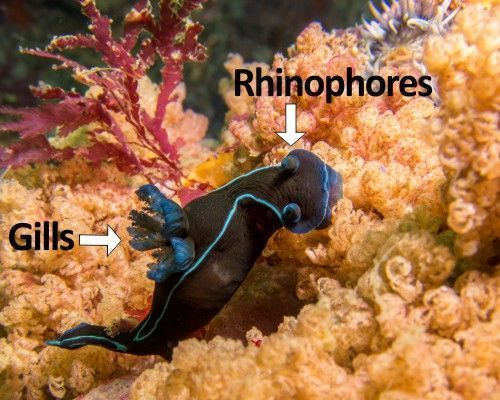Imagine a creature that looks like it was designed by a committee of artists on psychedelics: a sea slug that comes in every color of the rainbow, wearing its lungs on the outside of its body, and packing chemical weapons. Meet the nudibranch. The word "nudibranch" comes from the Latin nudus "naked" and the Ancient Greek (bránkhia) "gills" - a fitting name for these shell-less wonders that proudly display their gills like decorative feathers on their backs.
 Red-spotted dorid(Chromodoris heatherae) with its naked gills circled
Red-spotted dorid(Chromodoris heatherae) with its naked gills circled
Before I started scuba diving, I had no idea these little creatures existed. My very first nudi (as commonly referred to) was pointed out to me on my first dive after certification. It was a Chocolate Chip nudibranch (as it is locally known). It has a light-colored body with dark blotches.
That moment sparked an obsession. These creatures are nature's hidden treasures - most people swim right past them without noticing, but once you know what to look for, you start seeing them everywhere. I got my first nudibranch identification book - Nudibranchs of the Cape Peninsula and False Bay– and discovered I had stumbled into an underwater Easter egg hunt with hundreds of prizes to find.
These living jewels are marvels of evolution. At first glance, they might seem vulnerable - no shell, moving at a snail's pace - but they're masters of survival. Picture a tiny creature, usually no bigger than your thumb, equipped with two sophisticated sensory tentacles (rhinophores) that can smell prey and danger in the water. Behind these, like a decorative crown, sits a cluster of gills - their naked breathing apparatus that gives them their name.
 Black Nudibranch (Tambja capensis) showing the rhinophores and the gills.
Black Nudibranch (Tambja capensis) showing the rhinophores and the gills.
Nudibranchs occur in seas worldwide, from the Arctic to temperate and tropical regions, and can be found at virtually all depths.
But their most remarkable feature is their defense system. They use a combination of outstanding camouflage and aggressive toxicity. Some species secrete their own acidic compounds, while others perform a biological heist - stealing toxic compounds from their prey and incorporating them into their own tissues. It's like borrowing armor from your enemies.
Among the hundreds of species I've encountered, the Blue Gas Flame Nudibranch stands out as nature's finest artwork. Picture delicate blue flames dancing in slow motion - those are its cerata, external appendages that sway hypnotically in the ocean surge. These are used for breathing as this specific slug lacks gills entirely, and use their cerata to absorb oxygen. You can find these ethereal creatures, growing up to the size of your palm, along South Africa's coast from the Cape Peninsula to Port Elizabeth.

Blue Gas Flame Nudibranch (Bonisa Nakaza)
What's most astonishing is that some of the most flamboyant species are barely larger than your fingernail - tiny living rainbows that most divers swim past without noticing and only grow to be between 10 to 15mm.


Candy nudibranch (Cuthona speciosa)
These remarkable creatures changed how I see the ocean. They taught me that the most extraordinary things often hide in plain sight - you just need to slow down, look closer, and be patient. Whether you're a diver or not, knowing that such fantastic beings exist might make you wonder: what other wonders are we swimming past every day?
So, hopefully, this article finds its way to new divers as well as non-divers alike and sparks some interest in the weird and amazing underwater world of nudibranchs.
Ready to discover these underwater jewels for yourself? Join one of our guided dives in Cape Town, where experienced dive masters will help you spot and identify these fascinating creatures. Or take your exploration further with PADI's Underwater Photography Specialty course, where you'll learn the skills to capture these living works of art in their natural habitat.
We Protect what we Love. Join the movement!

by Madelein Wolfaardt



